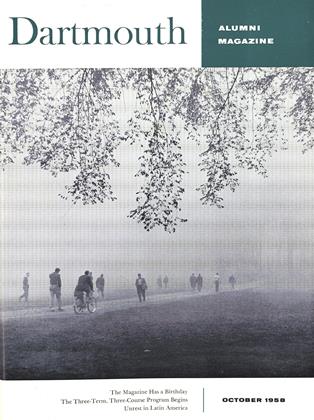Edited by John G. Truxal '45. New York:McGraw-Hill, 1958. 1048 pp. plus 75pp. ofindex. $18.50.
This handbook is primarily a source of information on the components of control systems. These components are of a diverse nature, including computers, magnetic amplifiers, electronic devices, electromechanical devices, and mechanical components. A staff of 36 specialists with John G. Truxal as editor-in-chief has prepared this book.
In the preface it is stated, "The explosive growth of automatic feedback control engineering during the past fifteen years has dramatically spotlighted the compartmentation of engineering. Whereas the young engineer has been educated largely along departmental lines (electrical, mechanical, etc.) and the practicing engineer has often classified himself even more restrictively, control engineering has forced the engineer to reject classical boundaries, to combine knowledge and techniques from diverse fields, and (most significantly), to seek, in that combining, the unity in the fundamental mathematics, physics, and chemistry which underlie the various specific fields of engineering. Further, from this unification not only has a new field of engineering arisen, but also the rush toward engineering specialization has been slowed (or possibly even reversed in certain areas). As the repercussions of these changes are felt in the educational institutions and research laboratories, the new field of automatic feedback control engineering influences and modifies all other branches of engineering.
"This remarkable nature of control engineering, by which it transcends specialization and compartmentation, must be evident in a handbook of this type."
The book is divided into 19 Sections. In Section 1 is a collection of tables and mathematical relations. Basic feedback control system theory is presented in Section 2. Design techniques are discussed in Sections 3 and 4. Sections 5 through 17 are devoted to a detailed discussion of some of the components used in control systems. Here, there are physical explanations of how the components work and mathematical descriptions of their use in typical control systems. Finally, regulators and process control systems are discussed in Sections 18 and 19.
The topics have been well chosen and various Sections are generally well written. An important need has been satisfied. The Control Engineers' Handbook belongs in the library of every control engineer.
 View Full Issue
View Full Issue
More From This Issue
-
 Feature
FeatureUnrest in Latin America
October 1958 By RICHARD B. McCORNACK -
 Feature
FeatureThe Magazine Has A Birthday
October 1958 By C.E.W. -
 Feature
FeatureHIS JOB Is Running Rockefeller Center
October 1958 By JAMES B. FISHER '54 -
 Feature
FeatureIndependence in Learning
October 1958 -
 Class Notes
Class Notes1953
October 1958 By LT. FREDERICK H. STEPHENS JR., CHARLES B. BUCHANAN -
 Class Notes
Class Notes1921
October 1958 By JOHN HURD, LINCOLN H. WELD
Books
-
 Books
BooksAlumni Articles
MARCH 1969 -
 Books
BooksPIRATES PURCHASE
JANUARY 1932 By E. P. K. -
 Books
BooksPUBLICATIONS
January, 1923 By J.M.P. -
 Books
BooksVICTORIAN ORIGINS OF THE BRITISH WELFARE STATE
May 1961 By JOHN G. GAZLEY -
 Books
BooksALEXANDER POPE. ELOISA TO ABELARD WITH THE LETTERS OF HELOISE TO ABELARD IN THE VERSION
MAY 1966 By JOHN HURD '21 -
 Books
BooksTHOMAS CRAWFORD: AMERICAN SCULPTOR.
OCTOBER 1964 By WINSLOW B. EAVES

